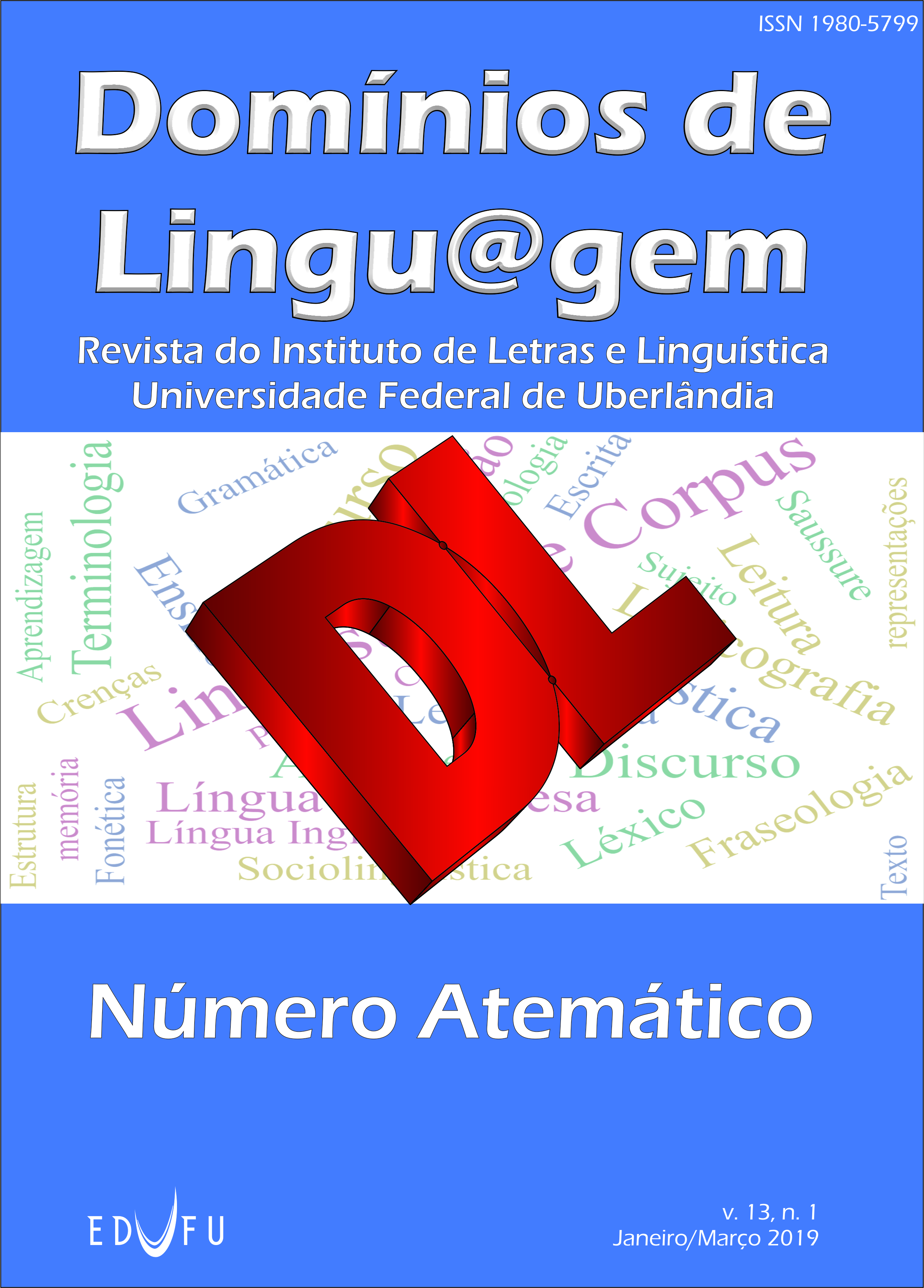Linguistic planning and maintenance
the construction of the Xikrín do Cateté language writing system
DOI:
https://doi.org/10.14393/DL37-v13n1a2019-13Keywords:
Xikrín language, Writing systems, Bilingual educationAbstract
In this study, we describe the steps involved in the elaboration of the written system of the Xikrín do Cateté language and a book to help the children to get the Xikrín writing system and develop literacy practices in their native language during the classes in village schools. These actions of linguistic planning aim at the maintenance of the Xikrín do Cateté language and culture. This people speak a variety of Kayapó language, belonging to the Jê family, Macro-Jê Stock (RODRIGUES, 1986). Xikrín people currently live in three villages, Cateté, the largest and the oldest one, with approximately 900 inhabitants, Djudjêkô with approximately 500 inhabitants, is 18 km from the Cateté village and Ô'odjãm, the youngest and smallest one, with a population estimated at 150 people, is located on the left bank of the river Cateté. The shortage of didactic material in the indigenous language is to some extent due to the absence of a writing system for the Xikrín language. The construction of such a system can enable the creation of literature in the indigenous language to guarantee a bilingual, differentiated and specific teaching that strengthens its language and its ancient culture. It is noteworthy that the writing system proposed here is founded in phonological criteria, without, however, disregarding political criteria that respect the autonomy of the Xikrín in the choice of symbols representative of the phonemes in their language.
Downloads
Metrics
References
BERRY, J. The making of alphabets. In: FISHMAN, J.(ed.) Readings in the sociology of language. Den Haag: Mouton Publisher, 1968, p. 737-753. DOI https://doi.org/10.1515/9783110805376.737
BRASIL, Ministério da Educação. Referenciais para a formação de professores indígenas/Secretaria de Educação Fundamental. Brasília: MEC;SEF, 2002. Disponível em: http://portal.mec.gov.br/seb/arquivos/pdf/Livro.pdf. Acesso em: 18 jun. 2018.
CALVET, L. J. As políticas linguísticas. São Paulo: Parábola Editorial, IPOL, 2017.
COOPER, R. Language planning and social change. Inglaterra: Cambridge University Press, 1989.
COSTA, L. S. Uma descrição gramatical da língua Xikrín do Cateté (família Jê, tronco Macro-Jê_. Tese de Doutorado. Brasília, Universidade de Brasília, 2015.
D'ANGELIS, W. da R.; VEIGA, J. A questão da educação indígena no 10º COLE. In: D'ANGELIS, W. da R.; VEIGA, J. (org.). Leitura e Escrita em Escolas Indígenas. Campinas, SP; ALB: Mercado de Letras, 1997. p. 13-21.
FISHMAN, J. Sociología de lenguaje. Madrid: Ediciones Cátedra, 1982.
MORI, A. C. Aspectos técnicos e políticos na definição de ortografias de línguas indígenas. In: D’ÂNGELIS, W. E.; VEIGA, J. (org.). Leitura e escrita em escolas indígenas: encontro de educação indígena no 10o COLE. Campinas: Mercado de Letras, 1997. p. 23-33.
NAZARENO, E.; FREITAS, M. T. U. Interculturalidade e práticas pedagógicas contextualizadas: uma perspectiva de-colonial para formação de professores/as indígenas. In: PIMENTEL-DA SILVA, M. S.; BORGES, M. V. (org.). Educação intercultural: experiências e desafios políticos pedagógicos. Goiânia: PROLIND/SECAD-MEC/PUNAPE, 2013. p. 113-131.
PIKE, K. L. Phonemics. A technique for reducing languages to writing. Ann Arbor: University of Michigan Press, 1947.
RODRIGUES, A. D. Línguas Brasileiras: para o conhecimento das línguas indígenas. São Paulo: Edições Loyola, 1986.
ROGERS, H. Writing systems: a linguistic approach. Blackwell Publishing, 2005.
SANVICÉN, P. Context i transversalitat de la política lingüística com a política pública. Revista tècnica de Política Lingüística. Número 41 (2008). Disponível em: https://repositori.udl.cat/bitstream/handle/10459.1/47304/015792.pdf;sequence=1.p.8-18. Acesso em: 25 abr. 2018.
SOARES, M. Alfabetização: a questão dos métodos. São Paulo: Contexto, 2016.
Downloads
Published
How to Cite
Issue
Section
License
Authors who publish in this journal agree to the following terms:
Authors retain the copyright and waiver the journal the right of first publication, with the work simultaneously licensed under the Creative Commons Attribution License (CC BY-NC-ND 4.0), allowing the sharing of work with authorship recognition and preventing its commercial use.
Authors are authorized to take additional contracts separately, for non-exclusive distribution of the version of the work published in this journal (publish in institutional repository or as a book chapter), with acknowledgment of authorship and initial publication in this journal.









